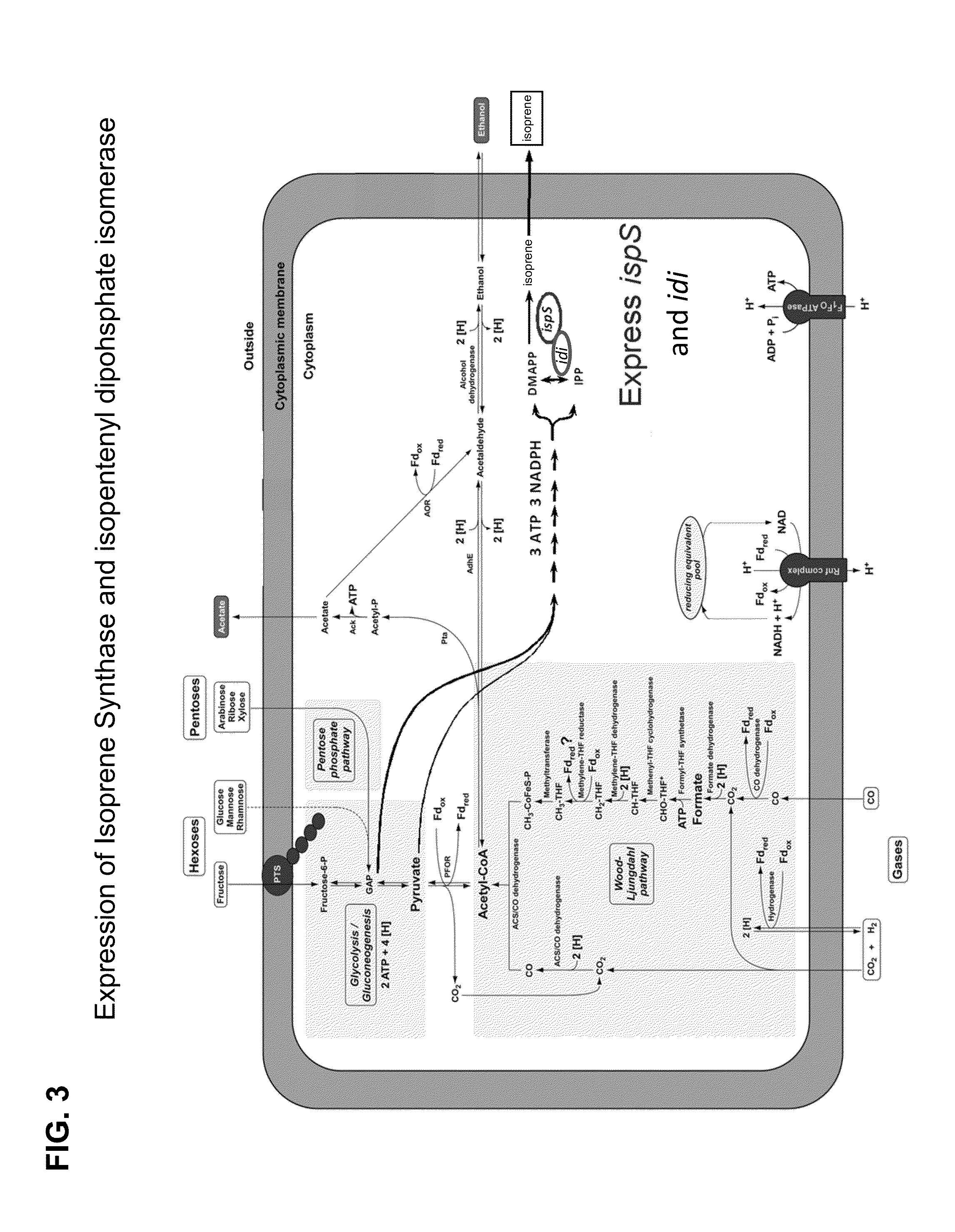Recombinant anaerobic acetogenic bacteria for production of isoprene and/or industrial bio-products using synthesis gas
- Summary
- Abstract
- Description
- Claims
- Application Information
AI Technical Summary
Benefits of technology
Problems solved by technology
Method used
Image
Examples
example 1
Production of Isoprene from Syngas Derived from Various Sources without Oxygen
[0358]The yield of isoprene from syngas depends upon the composition of the syngas. The generalized stoichiometric equation for the conversion of syngas to isoprene is shown in Equation 7.
(5-n)CO2+nCO+(14-n)H2+(n-10)H2O→1Isoprene+(n-5)CO2+(10-n)H2O Equation 7
[0359]The moles of CO2, CO, H2, and H2O in the syngas and the resulting stoichiometric molar yields of isoprene, CO2, and H2O according to Equation 7 are shown in Table 6 for n of 0 through 14. The same values are depicted graphically in FIG. 2. Negative values generated from the equation are treated as zero. Values of zero indicate that a component of the equation is absent from the syngas or is not produced as a product of the reaction. For example, in some aspects the syngas lacks one or more of CO2, CO, H2, and H2O. In some aspects, CO2 or H2O are not produced by the reaction.
TABLE 6MolesMolesMolesMolesMolesMolesMolesof CO2of COof H2of H2Oof C5H8o...
example 2
Production of Fuels from Isoprene Generated from Syngas
[0376]Isoprene derived from synthesis gas is converted to compounds with value as fuels. For example isoprene is hydrotreated with hydrogen in the presence of a catalyst to give monounsaturated isoamylenes and / or isopentane. These compounds can be blended directly into gasoline, or further processed into higher hydrocarbons in the C6 to C20 range by means of chemical catalysis methods known to those skilled in the art such as olefin dimerization and isoparaffin alkylation.
[0377]Alternately, isoprene is first oligomerized to C10 dimers and / or C15 trimers, both cyclic and linear using metal-based-catalysts, for example those based upon nickel, chromium, iron, ruthenium and palladium metals (other exemplary catalysts can be found in U.S. Provisional Patent Application Ser. No. 61 / 187,944, filed on Jun. 17, 2009) followed by hydrotreating to saturate double bonds. Isoprene is also dimerized to C10 compounds when heated to 150 to 250...
example 3
Production of Microbial Fuels from Syngas
[0378]This example demonstrates increased production of fermentative alcohols, e.g., ethanol, butanol; non-fermentative alcohols, e.g., isobutanol, methyl butanol; fatty alcohols, esters; isoprenoid alcohols, alkenes. Most of these compounds are synthesized from engineered pathway utilizing building block AcCoA via syngas fermentation. Pathways for production of these products are illustrated in FIG. 11.
[0379]Volatile fermentation products can be produced and recovered from synthesis gas fermentations, in addition to isoprene. Such compounds can be recovered from the fermentation off-gas stream provided that their volatility is high enough to prevent accumulation to toxic levels in the fermentor. Examples include, but are not limited to methanol, acetone, acetaldehyde, diacetyl, methyl acetate, ethyl acetate, diethyl ether and C2 to C4 hydrocarbons.
PUM
 Login to View More
Login to View More Abstract
Description
Claims
Application Information
 Login to View More
Login to View More - R&D
- Intellectual Property
- Life Sciences
- Materials
- Tech Scout
- Unparalleled Data Quality
- Higher Quality Content
- 60% Fewer Hallucinations
Browse by: Latest US Patents, China's latest patents, Technical Efficacy Thesaurus, Application Domain, Technology Topic, Popular Technical Reports.
© 2025 PatSnap. All rights reserved.Legal|Privacy policy|Modern Slavery Act Transparency Statement|Sitemap|About US| Contact US: help@patsnap.com



